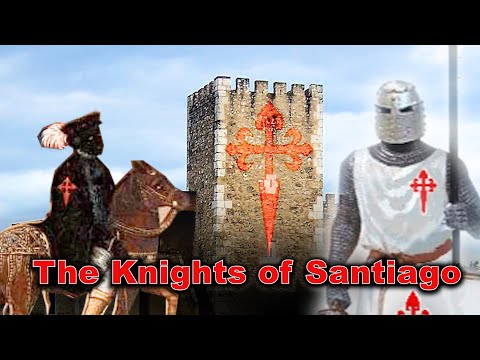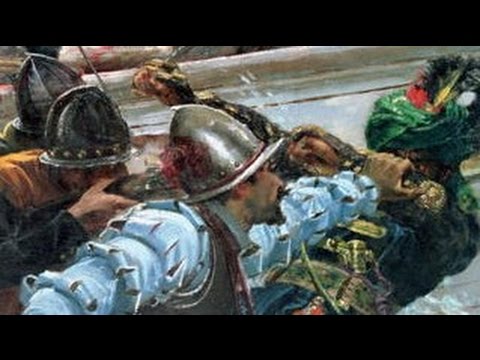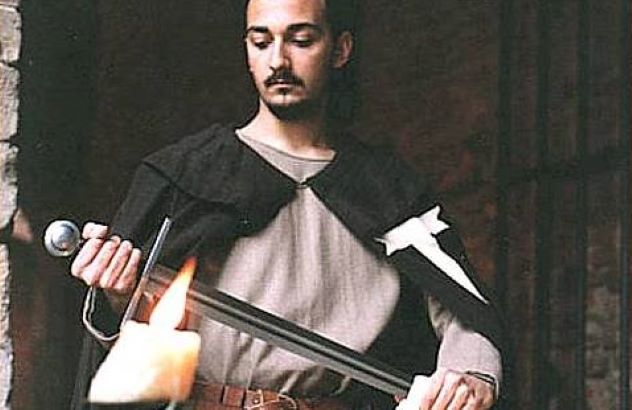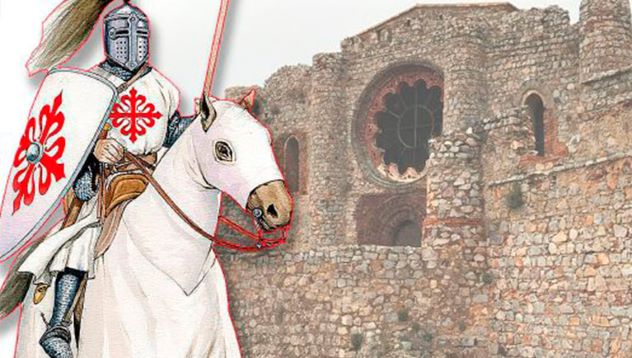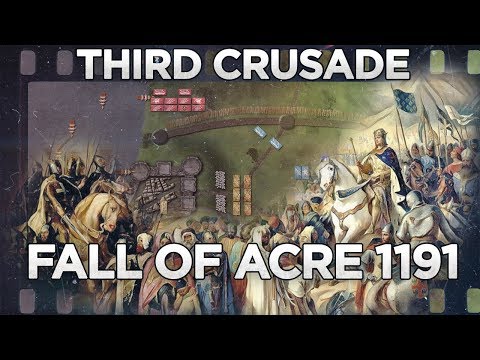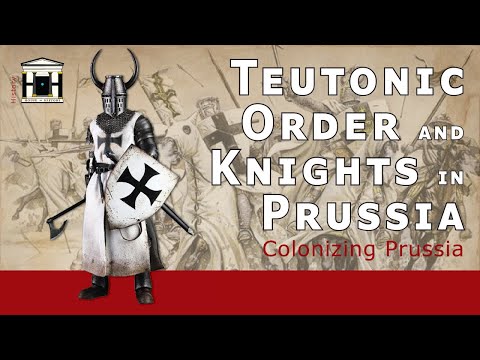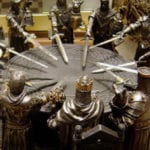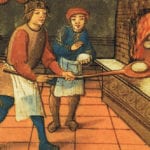Here are ten of the most powerful Orders of Knights that the medieval world had ever known.
10 The Order of Santiago
The Christian religious Order of Santiago was founded in Spain sometime around 1160. The primary purpose of the order was to fight Spanish Muslims and protect pilgrims traveling to the shrine of St. James at Compostella. The rules of this Christian military-religious order were based on those of the Augustinian monks and the Templars. However, unlike all other medieval orders, they didn’t lead a monastic lifestyle. The Knights of Santiago could marry and own personal possessions. Officially founded in the city of Caceres, the order quickly expanded to become a formidable force within the Reconquista, the series of wars that re-Christianized the Iberian Peninsula. While always remaining fairly small in number, the knights gained extensive fame and land across Europe. You could say they were the celebrities of their day.[1]
9 The Knights of Saint Stephen of Tuscany
Founded in 1561, the full name for this Roman Catholic Tuscan dynastic military order is the Holy Military Order of Saint Stephen Pope and Martyr! Saint Stephen was the first ever Christian martyr trialed and stoned to death after being accused of blasphemy by the supreme Jewish law court, the Sanhedrin. Stephen was likely a Greek Jew who converted to Christianity. The Knights of Saint Stephen were created by the first Tuscan Grand Duke Cosimo de Medici, and they followed the rule of the Benedictine Order. Cosimo de Medici himself was the first grandmaster of the order, and his successors to the role were the ensuing grand dukes of Tuscany. The main role of the knights was to fight the Ottoman Turks at sea and the Corsair pirates of the Mediterranean. They played a crucial role in securing victory at the Battle of Lepanto in 1571, which marked a turning point in preventing the expansion of the Ottoman Empire. Given the power of the Ottoman Empire up until that point, it takes a pretty badass order of knights to help turn the tables of history like that![2]
8 The Order of Saint James of Altopascio
This Italian warrior brotherhood was also known as the Order of the Tau due to the use of the Tau symbol as its official emblem. Their origins lie within the foundation of a hospital by Augustinian monks at Altopascio, Italy, sometime around 952. Set apart from the general clergy, a group of physicians known as Clerics comprised the majority of the order. They provided spiritual, medical, and military assistance to pilgrims along the perilous roads between the cities of Genoa and Lucca. Although the Order of the Tau had become fully militarized sometime in the 1050s, only in 1239 did it gain papal recognition as a military order. Despite the fact that the Knights of the Tau were never particularly large in number, they built numerous hospitals elsewhere, were very effective, and generally rather ahead of their time. Without a doubt, these guys were the trendsetters of Medieval Europe.[3]
7 The Livonian Brotherhood of the Sword
Alongside their pretty epic-sounding name, this Cistercian order of monastic warriors was one of the most significant knightly orders in Eastern Europe. The Brethren of the Sword, as they were also known, was established in the Livonian colony of Riga in 1202. The city of Riga had been settled the year before in what is now Latvia and Estonia to support the eastward Christianization of Europe. With the pope’s permission, the Livonian Brotherhood was founded as a permanent military body in Livonia to protect the conquests of the Christian Church. They were also tasked with forcibly converting the native pagans to Christianity—and force them they did! The Knights of the Livonian Brotherhood were required to be of noble birth and had to take vows of obedience, poverty, and celibacy. Membership wasn’t just limited to knights, however, as soldiers, clerics, and artisans also made up a portion of the Brotherhood. Their downfall came when they attempted to conquer lands belonging to groups known as the Curonians, Semigallians, and Samogitians. After experiencing excruciating defeat in battle, the Knights received a further scolding from the pope and the Holy Roman Emperor. They had used conversion tactics that were far too brutal and were forced to disband and reorganize as a branch of the Teutonic Knights (more on them later!).[4]
6 The Order of Calatrava
The Knights of Calatrava originated in 1158 as a result of the Reconquista in the Iberian Peninsula. The area had been a battleground between Christendom and Islam long before the Crusades came to the Holy Land. Before the Knights of Calatrava emerged, no large Spanish order comparable with those from elsewhere in Europe had fought there. When the royal castle of Calatrava was abandoned, however, King Sancho III of Castile ceded it to the abbot of a Cistercian monastery. Within a year, a group of soldiers and Cistercian monks had not only successfully defended the castle against the Moors but had also cleared the surrounding region of bandits. Forming a new military-religious brotherhood, the pope formally recognized the order in 1164. It became closely affiliated with the Cistercian abbey of Morimond but maintained its headquarters at Calatrava, despite its brief occupation by the Moors. The order played a significant role in the Reconquest of Andalusia and, by the 15th century, had a membership of 200,000. Although its numbers diminished leading up to its dissolution in the 19th century, the Knights of Calatrava were, at one point, one of the fiercest orders in Medieval Europe based on their sheer numbers alone. This was one big group of monks you wouldn’t want to mess with![5]
5 The Hospitallers of Saint Thomas of Canterbury
Named after Thomas Becket, the martyred Archbishop of Canterbury, the Hospitallers of St. Thomas was founded during the Third Crusade. During the siege of the city of Acre in 1191, a Christian chaplain was among Richard I’s English forces. He felt such sadness and compassion at the sight of so many Christian corpses that he rallied a small group to help him tend to the wounded and bury the dead. He soon formed an English order for the purpose of burying the Christian knights who had fallen in battle in the Holy Land. He also worked on raising the funds to bring home ransomed captives caught by the Saracens. Watch this video on YouTube The English monks of the order were eventually pressed into service, replacing the knights who had fallen through death or disease. With this, they became military monks who fought alongside the knights of numerous other orders battling in the Holy Lands. For their bravery and valor, the Hospitallers were rewarded by King Richard I, who accorded them the status of an Order of Chivalry. A title like that was probably the ultimate status symbol of the Medieval world.[6]
4 The Teutonic Knights
Like the Hospitallers of St. Thomas, the Teutonic Order was founded during the capture of Acre in 1191. During the siege, a group of German merchants formed a fraternity to nurse the sick. And they took over a hospital in the town from which to do so. The later withdrawal of a large number of German crusaders in 1197 caused the German princes and bishops to search for alternatives. So, in 1198, they militarized the fraternity to make it a military-religious order of knights. Watch this video on YouTube The Teutonic Order grew incredibly popular and became one of the most powerful orders of knights in the Holy Land. Had it not been for the equally impressive might of other knightly orders also there at the time, then they undoubtedly would have gained even more land and influence. Once the Crusades were over, however, the Teutonic Knights joined the movement to convert the pagans in Eastern Europe. Gaining major political power and land ownership, they quickly became the most important and dominant order of knights in that region. Little wonder then that the Livonian Brotherhood was eventually absorbed by them.[7]
3 The Hospitallers of Saint John
The formation of the Hospitallers of Saint John was bound up with the founding of a hospital in Jerusalem around 1070. Established by a group of monks as a place of rest for pilgrims, anyone who became ill during their travels was cared for, regardless of race or religion. Those who worked there were officially recognized by the Church as members of a new religious order in 1113. Known as the Hospitallers, they eventually took on a military role once the Crusaders captured Jerusalem. The Order was divided between those who retained a peaceful, religious role and those who fought and became known as the Knights of the Order of Saint John of Jerusalem. They briefly moved to Cyprus following the recapture of Palestine by Muslim forces in 1291, and then later to Rhodes and, finally, to Malta. They stayed in Malta until 1798, building the capital city of Valetta while they were there. The tiny island remained safe under their protection for so long, largely because the order was so effective in patrolling the Mediterranean with their ships. With those seafaring skills, they certainly could have given the Knights of Saint Stephen a run for their money.[8]
2 The Order of St. Lazarus
Founded shortly after the Hospitallers, the origin of the Order of Saint Lazarus also took place during the First Crusade of 1099. It was initially based in Jerusalem, where members would help lepers within the leprosarium just outside the city walls. The order evolved to assume a military role at some point before the early 13th century, and its knights participated in the most important campaigns in the Holy Land. The order’s range of influence soon expanded, and it eventually acquired a church, a convent, and a mill in Jerusalem. They also constructed hospitals, chapels, and various other establishments, expanding their role into Europe. Many of the knights were themselves lepers, and Hospitallers who caught the disease often had to transfer to the Order of Saint Lazarus. Even ordinary citizens who suffered from the disease were recruited to fight alongside the knights. This fact alone can make anyone appreciate what a tough bunch the Knights of Lazarus must have been.[9]
1 The Knights Templar
No list of Medieval knights would be complete without a nod to the legendary Knights Templar. The sheer scale of notoriety for this wealthy, powerful, and mysterious order is what secures them the top spot. Setting a precedent for groups of warrior monks, the Knights Templar was formed in the Holy Land around 1118. After the Christian capture of Jerusalem during the Crusades, groups of pilgrims visiting from Europe were often robbed and killed during their journeys to the various holy sites. In order to escort and protect them, a French knight and eight of his friends and relatives established a military order. Setting up quarters on Jerusalem’s sacred Temple Mount, they adopted its name and called themselves the Poor Fellow-Soldiers of Christ and the Temple of Solomon. The Knights Templar, as they came to be known, quickly grew in size and prominence. Tales of their adventures, military prowess, and work on behalf of their faith fascinated the Medieval world. They even set up a successful network of banks, which gave them a reputation for their financial acumen. However, they led pretty disciplined lives and had to follow a strict code of conduct. Pledging poverty, chastity, and obedience, they had to pray every day and were forbidden from drinking, gambling, and swearing. With so much work and very little play, the Knights Templar are some of history’s most notorious badasses![10]
